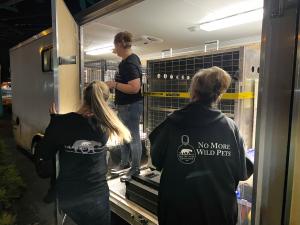Wildcat Sanctuary leads removal of 15 big cats, including tigers, lions, leopards, a jaguar seized from Safari Game Park
Minnesota's Wildcat Sanctuary coordinated the safe relocation of all wild cats to accredited sanctuaries and facilities.
A December report by the USDA said the park had one staff member to feed and care for hundreds of animals. Food storage freezers for the zoo’s large cats were empty, according to the agency. And a tiger was found in a freezer.
Tammy Thies of the The Wildcat Sanctuary secured placement and transport of 15 wild cats to 4 accredited sanctuaries of the Big Cat Sanctuary Alliance and one accredited zoo.
The Wildcat Sanctuary’s team, including their staff veterinarian, traveled 2,000 miles to ensure 4 lions, 1 tiger, 2 leopards, 1 jaguar, 3 lynx, 2 bobcats and 2 servals were safely removed from the West Coast Game Park and rehomed to accredited facilities.
Tammy Thies said, “With over 25 years of experience, our staff are professionals in relocating and transporting large predators safely and humanely. It took eight hours to assess, crate and load the cats into customized transports.”
Our sanctuary took in four of the cats, including a jaguar, leopard, lion and lynx. Since the investigation is ongoing, we cannot comment on the conditions of animals, but we’re excited that all will be going to accredited facilities like The Wildcat Sanctuary.
Being accredited by the Global Federation of Sanctuaries means sanctuaries like ours meet rigorous and peer-reviewed animal care standards and adhere to a demanding set of ethical and operational principles. We exceed animal welfare standards, provide specialized medical care and have the highest of husbandry practices,” Thies said.
The Wildcat Sanctuary receives no compensation for their rescue services or the lifelong care they provide. As a non-profit, they rely on public donations to help big cats in need like these.
The Wildcat Sanctuary provides a natural sanctuary to wild cats in need and inspires change to end the captive wildlife crisis. Combining natural and spacious habitats with a life free of exhibition, TWS allows all residents to live wild at heart. As a true sanctuary, we do not buy, breed, sell or exhibit animals. The Wildcat Sanctuary is accredited by the Global Federation of Animal Sanctuaries and a member of the Big Cat Sanctuary Alliance. More information can be found at WildcatSanctuary.org
Tamara Thies
The Wildcat Sanctuary
+1 320-245-6871
email us here
Visit us on social media:
Instagram
Facebook
YouTube
Legal Disclaimer:
EIN Presswire provides this news content "as is" without warranty of any kind. We do not accept any responsibility or liability for the accuracy, content, images, videos, licenses, completeness, legality, or reliability of the information contained in this article. If you have any complaints or copyright issues related to this article, kindly contact the author above.
Valor Tax Relief Expands Nationwide Presence While Founder Karim Hanna Builds Community and Gives Back Globally
American haute couture documentary up for accolades
After Nearly 30 Years of Service, Greentrike CEO to Pass the Torch
Więcej ważnych informacji
 Jedynka Newserii
Jedynka Newserii

 Jedynka Newserii
Jedynka Newserii

Konsument

Polacy nie korzystają z hossy trwającej na warszawskiej giełdzie. Na wzrostach zarabiają głównie inwestorzy zagraniczni
Od października 2022 roku na rynkach akcji trwa hossa, nie omija ona także warszawskiej giełdy. Mimo to inwestorzy indywidualni odpowiadają zaledwie za kilkanaście procent inwestycji, a o wzrostach decyduje i na nich zarabia głównie kapitał z zagranicy. Widać to również po napływach i odpływach do i z funduszy inwestycyjnych. Zdaniem Tomasza Koraba, prezesa EQUES Investment TFI, do przekonania Polaków do inwestowania na rodzimej giełdzie potrzeba zysków z akcji, informacji o tych zyskach docierającej do konsumentów oraz czasu.
Polityka
Obowiązek zapełniania magazynów gazu w UE przed sezonem zimowym ma zapewnić bezpieczeństwo dostaw. Wpłynie też na stabilizację cen

Unia Europejska przedłuży przepisy z 2022 roku dotyczące magazynowania gazu. Będą one obowiązywać do końca 2027 roku. Zobowiązują one państwa członkowskie do osiągnięcia określonego poziomu zapełnienia magazynów gazu przed sezonem zimowym. Magazyny gazu pokrywają 30 proc. zapotrzebowania Unii Europejskiej na niego w miesiącach zimowych. Nowe unijne przepisy mają zapewnić stabilne i przystępne cenowo dostawy.
Infrastruktura
Gminy zwlekają z uchwaleniem planów ogólnych zagospodarowania przestrzennego. Może to spowodować przesunięcie terminu ich wejścia w życie

Reforma systemu planowania i zagospodarowania przestrzennego rozpoczęła się we wrześniu 2023 roku wraz z wejściem w życie większości przepisów nowelizacji ustawy z 27 marca 2003 roku. Uwzględniono w niej plany ogólne gminy (POG) – nowe dokumenty planistyczne, za których przygotowanie mają odpowiadać samorządy. Rada Ministrów w kwietniu br. uchwaliła jednak ustawę o zmianie ustawy z 7 lipca 2023 roku, a jej celem jest zmiana terminu obowiązywania studiów uwarunkowań i kierunków zagospodarowania przestrzennego gmin na 30 czerwca 2026 roku. Wskazana data może nie być ostateczna z uwagi na to, że żadna z gmin nie uchwaliła jeszcze POG.
Partner serwisu
Szkolenia

Akademia Newserii
Akademia Newserii to projekt, w ramach którego najlepsi polscy dziennikarze biznesowi, giełdowi oraz lifestylowi, a także szkoleniowcy z wieloletnim doświadczeniem dzielą się swoją wiedzą nt. pracy z mediami.










.gif)

 |
| |
| |
|